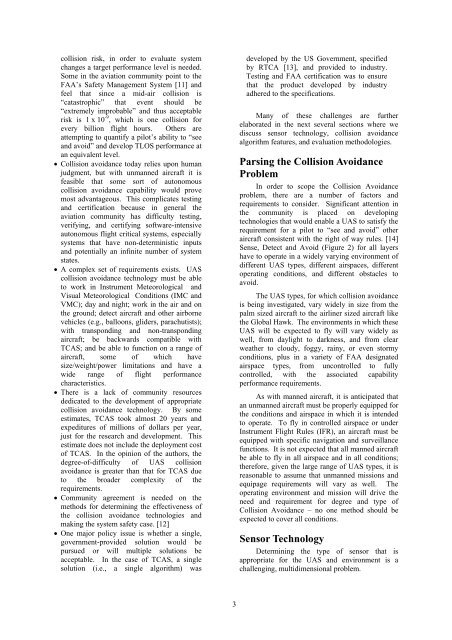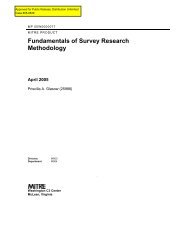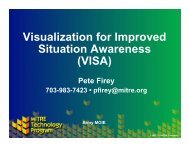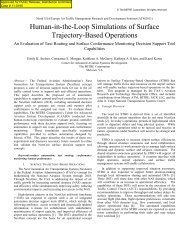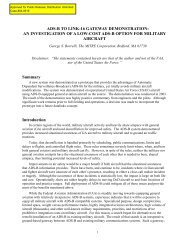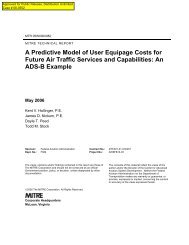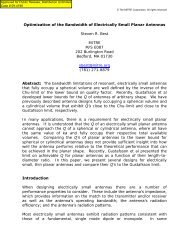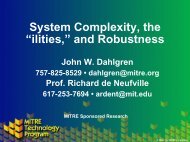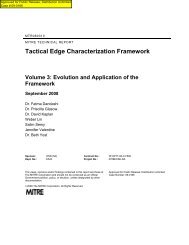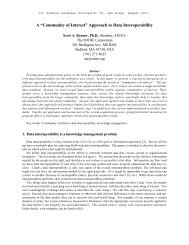Unmanned Aircraft Collision Avoidance: Technology ... - Mitre
Unmanned Aircraft Collision Avoidance: Technology ... - Mitre
Unmanned Aircraft Collision Avoidance: Technology ... - Mitre
Create successful ePaper yourself
Turn your PDF publications into a flip-book with our unique Google optimized e-Paper software.
collision risk, in order to evaluate system<br />
changes a target performance level is needed.<br />
Some in the aviation community point to the<br />
FAA’s Safety Management System [11] and<br />
feel that since a mid-air collision is<br />
“catastrophic” that event should be<br />
“extremely improbable” and thus acceptable<br />
risk is 1 x 10 -9 , which is one collision for<br />
every billion flight hours. Others are<br />
attempting to quantify a pilot’s ability to “see<br />
and avoid” and develop TLOS performance at<br />
an equivalent level.<br />
• <strong>Collision</strong> avoidance today relies upon human<br />
judgment, but with unmanned aircraft it is<br />
feasible that some sort of autonomous<br />
collision avoidance capability would prove<br />
most advantageous. This complicates testing<br />
and certification because in general the<br />
aviation community has difficulty testing,<br />
verifying, and certifying software-intensive<br />
autonomous flight critical systems, especially<br />
systems that have non-deterministic inputs<br />
and potentially an infinite number of system<br />
states.<br />
• A complex set of requirements exists. UAS<br />
collision avoidance technology must be able<br />
to work in Instrument Meteorological and<br />
Visual Meteorological Conditions (IMC and<br />
VMC); day and night; work in the air and on<br />
the ground; detect aircraft and other airborne<br />
vehicles (e.g., balloons, gliders, parachutists);<br />
with transponding and non-transponding<br />
aircraft; be backwards compatible with<br />
TCAS; and be able to function on a range of<br />
aircraft, some of which have<br />
size/weight/power limitations and have a<br />
wide range of flight performance<br />
characteristics.<br />
• There is a lack of community resources<br />
dedicated to the development of appropriate<br />
collision avoidance technology. By some<br />
estimates, TCAS took almost 20 years and<br />
expeditures of millions of dollars per year,<br />
just for the research and development. This<br />
estimate does not include the deployment cost<br />
of TCAS. In the opinion of the authors, the<br />
degree-of-difficulty of UAS collision<br />
avoidance is greater than that for TCAS due<br />
to the broader complexity of the<br />
requirements.<br />
• Community agreement is needed on the<br />
methods for determining the effectiveness of<br />
the collision avoidance technologies and<br />
making the system safety case. [12]<br />
• One major policy issue is whether a single,<br />
government-provided solution would be<br />
pursued or will multiple solutions be<br />
acceptable. In the case of TCAS, a single<br />
solution (i.e., a single algorithm) was<br />
3<br />
developed by the US Government, specified<br />
by RTCA [13], and provided to industry.<br />
Testing and FAA certification was to ensure<br />
that the product developed by industry<br />
adhered to the specifications.<br />
Many of these challenges are further<br />
elaborated in the next several sections where we<br />
discuss sensor technology, collision avoidance<br />
algorithm features, and evaluation methodologies.<br />
Parsing the <strong>Collision</strong> <strong>Avoidance</strong><br />
Problem<br />
In order to scope the <strong>Collision</strong> <strong>Avoidance</strong><br />
problem, there are a number of factors and<br />
requirements to consider. Significant attention in<br />
the community is placed on developing<br />
technologies that would enable a UAS to satisfy the<br />
requirement for a pilot to “see and avoid” other<br />
aircraft consistent with the right of way rules. [14]<br />
Sense, Detect and Avoid (Figure 2) for all layers<br />
have to operate in a widely varying environment of<br />
different UAS types, different airspaces, different<br />
operating conditions, and different obstacles to<br />
avoid.<br />
The UAS types, for which collision avoidance<br />
is being investigated, vary widely in size from the<br />
palm sized aircraft to the airliner sized aircraft like<br />
the Global Hawk. The environments in which these<br />
UAS will be expected to fly will vary widely as<br />
well, from daylight to darkness, and from clear<br />
weather to cloudy, foggy, rainy, or even stormy<br />
conditions, plus in a variety of FAA designated<br />
airspace types, from uncontrolled to fully<br />
controlled, with the associated capability<br />
performance requirements.<br />
As with manned aircraft, it is anticipated that<br />
an unmanned aircraft must be properly equipped for<br />
the conditions and airspace in which it is intended<br />
to operate. To fly in controlled airspace or under<br />
Instrument Flight Rules (IFR), an aircraft must be<br />
equipped with specific navigation and surveillance<br />
functions. It is not expected that all manned aircraft<br />
be able to fly in all airspace and in all conditions;<br />
therefore, given the large range of UAS types, it is<br />
reasonable to assume that unmanned missions and<br />
equipage requirements will vary as well. The<br />
operating environment and mission will drive the<br />
need and requirement for degree and type of<br />
<strong>Collision</strong> <strong>Avoidance</strong> – no one method should be<br />
expected to cover all conditions.<br />
Sensor <strong>Technology</strong><br />
Determining the type of sensor that is<br />
appropriate for the UAS and environment is a<br />
challenging, multidimensional problem.


